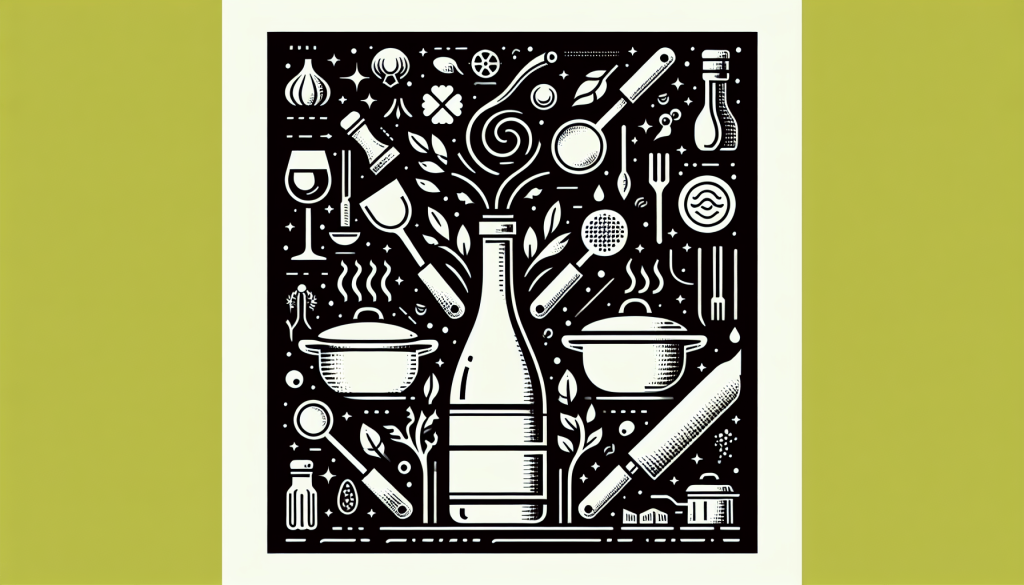If you love cooking and are looking for new ways to enhance the flavors of your dishes, then cooking with wine might just be the answer. From succulent sauces to tender meats, incorporating wine into your recipes can add a depth of flavor that takes your cooking to the next level. In this article, we will explore some of the best cooking tips for using wine in your culinary creations, helping you unlock a world of delicious possibilities. So grab a glass of your favourite wine, put on your apron, and let’s get cooking!

Choosing the Right Wine
When it comes to cooking with wine, the first step is choosing the right one. Consider the flavor profile of your dish and choose a wine that complements it. If you’re cooking a savory dish, like a steak or roast, opt for a dry red wine. The tannins in red wines help to balance out the richness of the meat, resulting in a delicious and well-rounded flavor. On the other hand, if you’re making a dessert, a sweet wine like a late-harvest Riesling or a Port would be the perfect choice. The sweetness in these wines enhances the sweetness in your dessert, creating a harmonious combination of flavors.
Understanding Wine and Food Pairing
Pairing the right wine with your food can elevate the flavors of both the dish and the wine. When cooking with red meat, such as a steak or lamb, reach for a bold and full-bodied red wine like a Cabernet Sauvignon or a Syrah. The rich flavors of the meat are complemented by the robust flavors of these wines. For fish and chicken dishes, opt for a crisp and refreshing white wine like a Sauvignon Blanc or a Chardonnay. The acidity in white wines helps to cut through the richness of the poultry or fish, resulting in a well-balanced and enjoyable meal. If you’re cooking lighter dishes like salads or vegetarian meals, a refreshing rosé wine would be a great choice. Rosé wines have a delicate fruitiness that pairs well with lighter flavors without overpowering them. Consider regional pairings as well, as certain wines are traditionally enjoyed with dishes from specific regions. For example, Italian dishes often pair well with Italian wines like Chianti or Sangiovese, while French cuisine is often enjoyed with French wines like Bordeaux or Burgundy.
When to Use Wine in Cooking
Wine is a versatile ingredient that can be used in various cooking methods to enhance the flavors of your dishes. When it comes to marinating or braising meats, wine is an excellent choice. The acidity in wine helps to tenderize the meat and infuse it with flavor. When deglazing a pan or making sauces, wine can add depth and complexity to your dish. The alcohol in the wine helps to dissolve and extract the flavorful bits stuck to the pan, creating a delicious sauce or base for your dish. Wine also adds richness and depth to soups and stews. The slow cooking process allows the flavors of the wine to meld with the other ingredients, resulting in a hearty and flavorful dish. Additionally, wine can be used in baking to add moisture and complexity to cakes, breads, and desserts.
Amount of Wine to Use
When cooking with wine, it’s important to use the right amount to achieve the desired flavor. Start with small amounts and taste as you go. You can always add more wine if needed, but it’s harder to reduce the flavor if you use too much. Balance the wine with other flavors in your dish to create a harmonious taste. Avoid overpowering the dish with the taste of the wine by using it as a complement rather than the main flavor. Consider the alcohol content of the wine you’re using, as it can affect the overall flavor of the dish. Higher alcohol wines can impart a strong alcohol taste, so make sure it’s balanced with other flavors in the dish.

Cooking Methods with Wine
Different cooking methods can bring out different flavors in wine-infused dishes. Simmering is a common method used when cooking with wine. Simmering allows the flavors of the wine to meld with the other ingredients, creating a harmonious blend of flavors. Flambéing is a technique where alcohol is set alight to burn off excess alcohol and create a rich and caramelized flavor. Steaming is a gentle cooking method that preserves the delicate flavors of the wine while infusing them into the dish. Poaching involves cooking the food in a liquid, often a wine-based broth, resulting in a moist and flavorful dish.
Tips for Wine Reductions
Reducing wine is a popular technique used to concentrate its flavors and create a rich and flavorful sauce. When choosing a wine for reduction, opt for one that complements the flavors of your dish. For example, if you’re making a beef stew, a hearty red wine like a Merlot or a Cabernet Sauvignon would be a great choice. Reduce the wine over low heat to prevent it from burning and becoming bitter. Stir the wine frequently to ensure even reduction and to prevent it from sticking to the pan. If the reduction becomes too thick, you can adjust the consistency by adding stock or cream.
Storing and Preserving Cooking Wine
When you have leftover wine from cooking, it’s important to store it properly to maintain its quality. Refrigerate open bottles of wine to slow down the oxidation process. Use the wine within a week to ensure its freshness and flavor. If you have a small amount of wine left, freeze it in ice cube trays for later use. This way, you can easily thaw and use the wine in smaller portions as needed. If you cook with wine frequently, consider investing in wine preservers or vacuum sealers. These tools help to remove air from the bottle, prolonging the life of the wine and preserving its flavors for future use.
Dealing with Unwanted Wine Flavors
Sometimes, the flavors of wine used in cooking can become overpowering or unbalanced. If you find that your dish tastes too alcoholic, you can reduce the alcohol content by simmering the dish for a longer period or by adding a small amount of sugar or honey to balance the flavors. If your dish is too acidic, you can reduce the acidity by adding a small amount of sugar or by adding a creamy element like butter or cream. If your dish is too sweet, you can balance the sweetness by adding a dash of acid, such as lemon juice or vinegar. In case your dish turns out bitter, try neutralizing the bitterness by adding a pinch of salt or a sweet ingredient like honey or maple syrup.
Adding Wine at Different Stages of Cooking
The stage at which you add wine during the cooking process can affect the final taste of your dish. When marinating or braising meats, it’s best to add the wine early on to impart its flavors throughout the cooking process. This allows the meat to absorb the wine and tenderize. For developing rich and complex flavors, add wine midway through the cooking process. This gives the wine enough time to blend with the other ingredients and create a well-rounded taste. If you want to add brightness and freshness to your dish, add a splash of wine towards the end of the cooking process. This helps to preserve the delicate flavors of the wine and adds a final touch to your dish.
Substituting Wine in Recipes
If you prefer not to use alcohol or don’t have wine on hand, there are alternatives you can use in your recipes. Non-alcoholic options like grape or apple juice can provide a similar sweetness and flavor to wine without the alcohol content. If you’re looking for a savory substitute, broth or stock can be used to add depth and richness to your dishes. Fruit juices, such as lemon or lime juice, can add acidity to your recipes and help to balance flavors. Vinegar, particularly red or white wine vinegar, can also be used to provide acidity and depth. When substituting wine, consider the compatibility of the alternative with the other ingredients in your dish to ensure a harmonious flavor.
In conclusion, cooking with wine can add complexity, depth, and richness to your dishes. By choosing the right wine, understanding food and wine pairings, and experimenting with different cooking methods and amounts, you can create flavorful and enjoyable meals. Whether you’re marinating meats, deglazing pans, or adding a splash of wine towards the end, wine can elevate your culinary creations to a whole new level. So grab a bottle, put on your apron, and get ready to create delicious dishes bursting with the flavors of wine. Cheers to cooking with wine!
